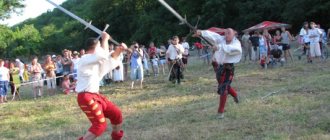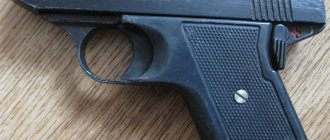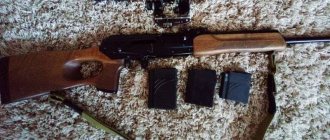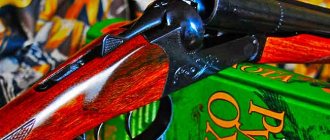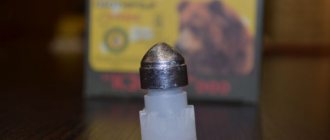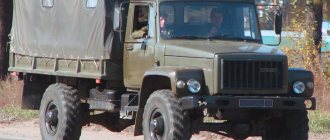| This article is proposed for deletion. An explanation of the reasons and the corresponding discussion can be found on the Wikipedia page: Towards deletion / July 15, 2020. While the discussion process is not completed, you can try to improve the article, but you should refrain from renaming or unmotivated removal of content, for more details, see the guide to further action. Do not remove the mark for deletion until the end of the discussion. Last modified by InternetArchiveBot (contribution, logs) at 07:37, 13 September 2020 (UTC; about 70 days ago). Administrators: links here, history, magazines, delete. |
Vepr Y
- a mythical animal from the work of the Strugatsky brothers “It’s Hard to Be a God”, a character in Arkanar folklore, whose liver has magical properties[1].
Description
Despite the legends associated with it, the Y boar is probably based on a real animal from the Trans-Straits. Lives in the Hiccuping Forest. He is ferocious, growls loudly when enraged, and sometimes makes muttering sounds when calm. Invulnerable to iron, but easily penetrated by bone. Also often called "naked boar Y"
, probably because it is practically hairless. According to legend, cursed by Saint Mika[2].
The dried spleen of the boar Y, which has a putrefactive taste, is used to prepare medicinal potions (this is mentioned in the work of Dr. Budakh “On herbs and other grains that can mysteriously serve as a cause of sorrow, joy and tranquility, as well as on the saliva and juices of reptiles, spiders and naked boars, possessing the same and many other properties"
)[3].
Biologist[4] and science fiction writer[5] Sergei Yastrebov emphasizes that since Dr. Budakh speaks seriously about the boar, he is not a purely mythical creature. He suggests that this large, clumsy animal, externally related to the ungulates, is a weakly specialized mammal of the “Paleogene block” or even a lizard [6].
Vepr 12 Molot - modification of VPO 205 04
VPO 205 04 – but this option is very interesting. Available in two versions. With wooden stock and telescopic ATI. Both options have a barrel length of 483mm. Claimed weight: 3.9 kg. How the manufacturer achieved such a weight reduction is still unclear.
The cut of the barrel also has a thread for installing attachments. The VPO 205 04 receiver has a bevel at the rear.
Minuses
— the telescopic stock gets loose quite quickly, but it can be easily adjusted to your figure and clothing (clothes are much thicker in winter). The wooden butts of these carbines are famous for their convenience and adaptability, but in general the carbine turns out to be quite bulky.
Usage options:
sports, self-defense, recreational shooting, hunting.
origin of name
Analyzing the names given by the Strugatskys for their heroes and for other elements of the work “It’s Hard to Be God”, in her dissertation for the degree of candidate of philological sciences O. S. Bochkova notes that the names “boar Y”, “beast Pekh” belong to the class “phonological new formations, that is, artificially created configurations of sounds”
. In general, many of the names in this novel were constructed by analogy with the Japanese syllabic alphabet of fifty sounds, which is usually used to transliterate hieroglyphs into Russian: Re-ba, Tsu-re-n, Ki-un, Ru-ma-ta[8] [9].
Distinctive features of the weapon
Despite the apparent similarity, the Vepr and Saiga carbines have a number of significant differences:
- Weight . “Vepr” is almost a kilogram heavier than its rival.
- Appearance . The structure of “Saiga” is dominated by smooth forms, while “Vepr” contains sharper and rougher transitions.
- Barrel thickness . The barrel metal of the “Vepr” is thicker than the “Saiga”, by approximately 0.2 mm.
- Recoil . The recoil of the Saiga carbine is softer than that of the Vepr of the same modification.
- Descent . The trigger of both carbines works quite clearly, but on the Saiga it is a little stretched, which can lead to the finger slipping if you are not shooting skillfully or when shooting with wet hands.
- Price . On store shelves, it will not be difficult to find models of both carbines. However, "Vepr" prevails at an increased price compared to its competitor, on average by thirty to forty percent. In some places, you can even find a difference of 100%.
- Accuracy . First of all, it must be said that both carbines comply with the established GOST 28653-90. At the same time, “Vepr” is slightly superior in its performance to “Saiga”.
Cultural influence
At the tenth World Poetry Day, the evening “From Piglet to the Boar Y” was held, part of the series of events of the Crimean Club “Zoosophy”[1][10].
Speaking about the comedy film “Operation “Y” and other adventures of Shurik” by Leonid Gaidai and about the “naked Boar Y” from the worlds of the Strugatsky brothers, writer Andrei Balabukha notes the big role of “” in Russian art.[11]
In the computer game of the RPG genre "It's Hard to Be a God" by the Akella company, the naked boar Y is present as one of the monsters, and also (if the character has the appropriate skills) - raw materials for healing potions[12].
Subspecies[ | ]
Central European wild boar Carpathian wild boar from Hungary Indian wild boar Japanese wild boar
Due to the variability of habitat - from the dark coniferous taiga zone to deserts, as well as all mountain belts up to the Alpine - the geographical variability of wild boars is very high. There are 16 subspecies of Sus scrofa
, which are combined into 4 regional groups[17]:
- Western S. scrofa scrofa
, or
Central European wild boar
(common in Spain, Italy, France, Germany, Benelux, Denmark, Poland, Czech Republic, Slovakia and Albania) - S. scrofa majori
, or
Maremma wild boar
(common in Maremma, Italy) - S. scrofa meridionalis
, or
Mediterranean wild boar
(common in Andalusia, Corsica and Sardinia) - S. scrofa algira
, or
North African wild boar
(common in Tunisia, Algeria and Morocco) - S. scrofa attila
, or
Carpathian (Romanian, Caucasian) wild boar
(common in the Carpathians, including Romania, Hungary and Ukraine, the Balkans, Transcaucasia, the Caucasus, the Asia Minor peninsula, the Caspian Sea coast and northern Iran) - S. scrofa lybicus
, or
Anatolian boar
(common in Transcaucasia, Turkey, Levant, Israel and the former Yugoslavia) - S. scrofa nigripes
, or
Central Asian wild boar
(common in Central Asia, Kazakhstan, eastern Tien Shan, western Mongolia, Kashgar and Afghanistan and southern Iran)
- S. scrofa davidi
, or
Central Asian wild boar
(common in Pakistan, northwestern India and southeastern Iran)
, or
Indian wild boar
(common in India, Nepal, Burma, Thailand and western Sri Lanka)
- S. scrofa sibiricus
, or
Transbaikal wild boar
(distributed on the shores of Lake Baikal, in Transbaikalia, northern and northeastern Mongolia)
, or
Ussuri wild boar
(common in eastern China, on the shores of the Ussuri and Amur bays)
, or
Japanese wild boar
(common in Japan (except Hokkaido and Ryukyu Islands)
, or
Ryukyu wild boar
(common in the Ryukyu Islands)
, or
Taiwan wild boar
(common in Taiwan)
, or
North China wild boar
(distributed along the coast of China south to Vietnam and west to Sichuan)
- S. scrofa vittatus
, or
Malaysian wild boar
(common in Peninsular Malaysia, Indonesia from Sumatra and Java east to Komodo)
Notes
- ↑ 1 2 Igor Sid.
World Poetry Day → Pork in literature and in life // October Magazine. - 2009. - No. 7. - The Hiccupping Forest, Dictionary of Science Fiction
- Borisov V.I.
“M—Ya” // Worlds of the Strugatsky brothers: encyclopedia. - M.: AST, 1999. - T. 2. - P. 415. - 558 p. — ISBN 5-2370-1562-X. - S. A. Yastrebov.
The origin of chordates: a modern view of the problem. batrachos.com (June 10, 2012). Retrieved June 19, 2012. Archived September 26, 2012. - Science Fiction: Who's Who, Yankovsky—Yacheykin
- Black mirror of the Earth. On the issue of the global history of the planet Aurora, Sergey Yastrebov
- Chertkov A.
Time of students 3. - M.: AST, 2000. - 541 p. — (Worlds of the Strugatsky brothers). — ISBN 5-1700-0541-5. - Bochkova Olga Sergeevna.
Categories of modality, time and space in the SF genre // Abstract of the dissertation for the degree of candidate of philological sciences. — Saratov, 2006. (inaccessible link) - Bochkova Olga Sergeevna.
New formations in science fiction as a way of realizing the author's modality // Science Fiction and Technology (in memory of Stanislav Lem). Collection of materials of the International Scientific Conference on March 29–31, 2007. - P. 244. - ISBN 978-5-904214-19-7. Archived March 16, 2012. - Elena Kashina
. The poets were screwed. Gogol’s devil is actually a pig, Nezavisimaya Gazeta. Ex Libris (30 April 2009). Retrieved June 18, 2012. - Reasoning around “Y”, or Fantast involuntarily: (On the work of M. Weller) // Two hundred. - St. Petersburg, 1995. - No. G. - P. 37-46.
- Svetlana Karacharova.
B // Gambling addiction. - 04/26/2005.
Habitats and food
For shelter, boars choose places that are impassable for other creatures. They are most often found in dense mixed forests or reed thickets. The herd has a nomadic lifestyle. In search of food, wild boars travel several kilometers a day. Although pigs are considered omnivores, their diet mainly consists of various parts of plants. The boar feeds:
- roots of reeds, reeds;
- nuts, acorns;
- apples and pears falling to the ground.
The herd does not pass by fields cultivated by humans, which causes significant damage to agriculture. Pigs happily eat:
- corn;
- potatoes, beets;
- cereals.
In ponds, pigs look for mollusks, amphibians, and reptiles. Mice nests and insect larvae are torn out in the meadows.
Attention! When feeding, the boar moves against the wind. This allows you to smell danger and take action in time.
When summer comes and hot days set in, boars feed at night. During daylight hours they lie down in damp, shady places. In winter it's the other way around. The herd spends the night in secluded places, and goes out to feed during the warmest time during the day.
Literature
- Borisov V.I. “M—Ya” // Worlds of the Strugatsky brothers: encyclopedia. - M.: AST, 1999. - T. 2. - P. 415. - 558 p. — ISBN 5-2370-1562-X.
- Black mirror of the Earth. On the issue of the global history of the planet Aurora, Sergey Yastrebov
| This is an article about science fiction. You can help the project by adding to it. |
| The World of Noon by the Strugatsky brothers | |
| Novels and stories | Noon, XXII century • Attempt to escape • Distant Rainbow • It's hard to be a god • Anxiety • Inhabited island • Kid • Guy from the underworld • Beetle in an anthill • Waves extinguish the wind |
| see also | Country of Crimson Clouds • Forgotten Experiment • Test of SKIBR • Particular Speculations • The Path to Amalthea • Trainees • Predatory Things of the Century • Time of Students |
| Planets | Arkanar • Saraksh • Minor planets |
| Races | Golovans • Leonidians • Ludens • Humans • Inhumanoids of the Ark • Wanderers • Tagoreans |
| Characters | Gag • Leonid Gorbovsky • Maxim Kammerer • Gennady Komov • Rudolf Sikorsky • Minor characters |
| Miscellaneous | Massaraksh • High theory of education |
| Film adaptations | It's Hard to Be a God (1989) • It's Hard to Be a God (2013) • Inhabited Island |
| Games | Inhabited Island (Afterword • Alien Among Aliens • Earthling) • It’s hard to be a god • Inhabited Island |
| Other | Inhabited Island (comic) • Black Pawn (story) |
boar youf, boar yk, boar yoou, boar youtube
Hatching of offspring
Pregnancy of females can last about 120 days, after which they are temporarily separated from their herd to build a nest in some quiet place. The new “home” for the brood looks more like a hut made of branches. During this crucial period, the mother becomes as aggressive as possible, which allows her to reliably protect and protect her cubs. Unlike males, the female does not have huge, terrifying fangs, but this does not mean at all that she is not dangerous. When defending or attacking, she is capable of overpowering and trampling her victim to death. After the offspring grow up, all family members return to the herd.
View gallery



